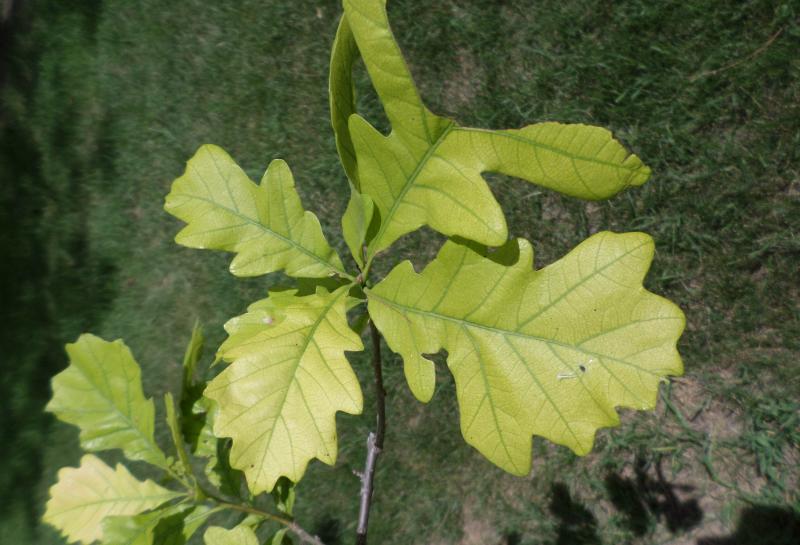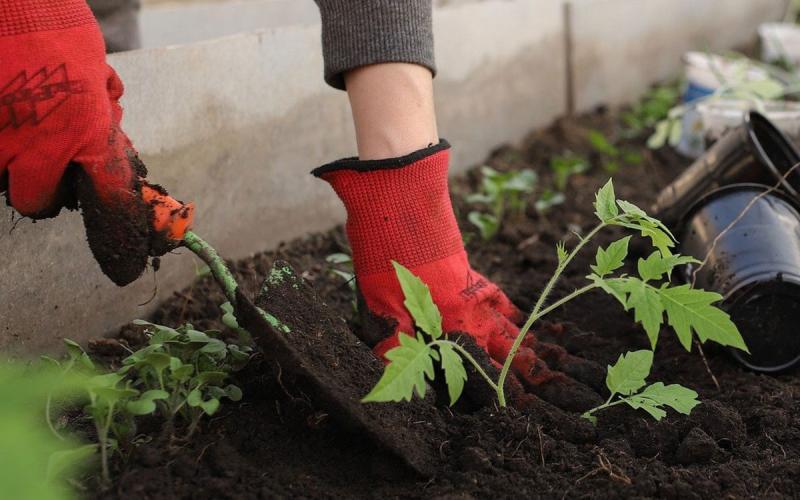Chlorosis
Chlorosis, a condition where the leaf veins remain green but the surrounding foliage turns pale green or yellow, is a common occurrence on certain tree species in South Dakota. The ones where we typically see these symptoms appearing are Amur maple, eastern pin oak, red maple, red oak, river birch, and silver maple. The reason for this chlorosis is not a fungus or other pathogen, but the lack of iron (Fe) or manganese (Mn) in the foliage. The lack of Fe or Mn is not due to the soils containing inadequate amounts of these microelements, but our alkaline soils rendering these elements into forms not available to the tree. Any soil with a pH greater than 7.2, and that includes many of the soils in our communities, can result in these aforementioned trees turning almost a golden yellow by mid-summer. Severely affected leaves can also begin to fall prematurely leaving the tree bare by autumn. Some trees species, red maples and eastern pin oaks, may dieback if afflicted with this disorder every year.
Other Sources of Yellowing

Not all yellow leaves are due to a microelement deficiency. Trees may have yellowing leaves due to drought, flooding, aphids or any number of other stresses. Some tree cultivars such as the ‘Princeton Gold’ Norway maple produce yellow leaves (Figure 1), hence it is important to rule out other reasons for the yellowing foliage before assuming it’s the lack of Fe or Mn.
The simplest check is:
- The foliage is truly cholorotic, the foliage is yellow but the veins are green or a light green.
- The species is of the ones identified as being susceptible to microelement deficiency.
- The soil is alkaline.
If these three conditions are met, the most likely the tree is not able to obtain enough Fe or Mn.
Management Tips
Since the problem is not the lack of Fe or Mn, merely adding these microelements as a fertilizer to the soil will usually not solve the problem. Pounding nails into the trunks is not helpful as this is a poor way of getting iron in the tree and most nails do not contain a lot of extractable iron. The solution is either spray the foliage with a solution containing both minerals, implanting Fe or Mn capsules into the trunk, fertilizing with a chelated form of Fe or Mn or reducing the soil pH so the microelements already in the soil become available. All these treatments work best if applied early in the growing season, as the leaves are expanding.
Foliage Sprays
Spraying the foliage with ferrous or manganese sulfate will provide a quick “green up” of the foliage but only if the application is made just after the foliage fully expands. If done late in the season the leaves may not color well. The application is also only a temporary fix and often the leaves or newer leaves will become yellow later in the summer. Misapplication of these sprays can also damage foliage and stain concrete and stucco. The applications should also be made in the evening, while temperatures are cooler, as these microelement solutions can result in leaf injury.
Trunk Implants
Implanting Fe or Mn in the trunk can provide a green-up within a few weeks of application and the benefits may last a year or two. There are implants that are available for homeowner use, but these are rarely carried in local garden centers and department stores. The implants should be placed low on the trunk and a sharp drill bit used to make the holes. The products are easy to apply but the directions should be carefully followed to avoid any unnecessary injury to the tree. Drilling holes into the tree creates wounds that may result in decay.
Chelating Agents
Chelated forms of Fe and Mn can be applied to the soil and these applications provide benefits for usually a year or two but may take several months before the leaves lose their chlorotic appearance. The chelating agent keeps the Fe or Mn in a form available to the tree but not all chelating agents are effective in our slightly-to-moderate alkaline soils. The best chelating agent for our soils contain FeEDDHA (Iron Chelate Fertilizer) and this one should be on the label. Chelated Fe and Mn is available at many garden centers and farm supply stores but you still may have to look around.
Soil Treatment
Altering the pH so that the Fe and Mn in the soil is available to the tree is the best solution, but is not easily done. The alkaline soils in our state are well-buffered meaning the pH is not easily lowered or will stay low for a very long time. However it is worth a try and the most common acidifying agent is elemental sulfur (sold as organic soil acidifier). This can be easily purchased in the garden section of most garden centers. When applying this product, carefully read and follow the label directions. Also do not expect the results to be “overnight."


